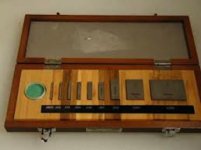Anyone know about what the typical life expectancy of a decent micrometer is (Starrett 436, Mitutoyo 103, etc.)?
I know everyone will have opinions on their personal one(s) they have had for ages, but what I am looking for are the ones that EVERYONE in the shop uses, (newbie, experienced, “Mr. Not mine, don’t care about it”, etc.).
Have some that are getting worn, (guessing circa-1970's... like the rest of our IMTE), and senior management apparently doesn't understand why all of a sudden we need to shell out $2K for a new 0-12" set. Apparently my opinion regarding their condition or that four of 12 are over their DIN-863 limits don't count. What is being heavily relied upon is that my retired predecessor "ensured all IMTE he calibrated passed calibration" (DON'T ask for records, none exist). Unfortunately, I'm not that type of person, my reputation means more than that... my "awaiting repair" pile is growing rather quickly.
I know everyone will have opinions on their personal one(s) they have had for ages, but what I am looking for are the ones that EVERYONE in the shop uses, (newbie, experienced, “Mr. Not mine, don’t care about it”, etc.).
Have some that are getting worn, (guessing circa-1970's... like the rest of our IMTE), and senior management apparently doesn't understand why all of a sudden we need to shell out $2K for a new 0-12" set. Apparently my opinion regarding their condition or that four of 12 are over their DIN-863 limits don't count. What is being heavily relied upon is that my retired predecessor "ensured all IMTE he calibrated passed calibration" (DON'T ask for records, none exist). Unfortunately, I'm not that type of person, my reputation means more than that... my "awaiting repair" pile is growing rather quickly.


 ). Have used a cheap x20 pocket microscope; shows every face, carbide and not, to be scratched, chipped, and/or grooved.
). Have used a cheap x20 pocket microscope; shows every face, carbide and not, to be scratched, chipped, and/or grooved.



